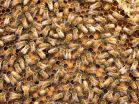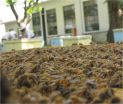INFORMATION:
Other authors on the paper include Xingyu Yang, graduate student in bioinformatics and Soojin Yi, associate professor of biology, both at Georgia Institute of Technology, and Elina Lastro Niño, assistant extension apiculturist, University of California, Davis.
The U.S. Department of Agriculture and National Science Foundation provided funding for this research.
Honey bees use multiple genetic pathways to fight infections
2015-03-26
(Press-News.org) Honey bees use different sets of genes, regulated by two distinct mechanisms, to fight off viruses, bacteria and gut parasites, according to researchers at Penn State and the Georgia Institute of Technology. The findings may help scientists develop honey bee treatments that are tailored to specific types of infections.
"Our results indicate that different sets of genes are used in immune responses to viruses versus other pathogens, and these anti-viral genes are regulated by two very distinct processes -- expression and DNA methylation," said David Galbraith, graduate student in entomology, Penn State.
The results will appear in todays (Mar. 26) issue of PLOS Pathogens.
According to Christina Grozinger, director of the Penn State Center for Pollinator Research, beekeepers lose an average of 30 percent of their colonies every winter and an average of 25 percent in the summer.
"Honey bees have more than 20 types of viruses, and several of them have been linked to losses of honey bee colonies," she said. "Yet, beekeepers currently do not have any commercially available methods to reduce viral infections."
With a goal of uncovering which genes increase or decrease their activity in response to the presence of viruses, the researchers measured expression levels of all genes in the honey bee genome in both infected and uninfected bees. They found that the RNAi pathway had increased activity and, therefore, is likely an important anti-viral immune pathway in bees.
"Previous studies suggested the RNAi pathway was involved in anti-viral immune responses in bees, but we showed that expression levels of many genes in this pathway are significantly higher in virus-infected bees," said Grozinger. "The RNAi pathway helps to cut up and destroy viral RNA so it is not infectious."
Scientists and beekeepers are increasingly interested in using RNAi approaches to control viruses and parasites in agricultural crops and in honey bee colonies, according to Grozinger.
"We will need to make sure that any artificial RNAi approaches do not interfere with the natural anti-viral RNAi mechanisms in honey bees," Grozinger said.
In addition to examining gene expression in virus-infected versus uninfected honey bees, the researchers also scanned the honey bee DNA for extra methylation marks that may have been added or removed from genes in virus-infected bees.
The team found that viral infections do change the pattern of DNA methylation in honey bees, and in a completely different set of genes from the ones in the RNAi pathway. Many of these differentially methylated genes are also involved in anti-viral responses in mammals, but they have not previously been linked to anti-viral responses in insects, said Grozinger.
"We found that there was very little overlap between differentially expressed and differentially methylated genes, suggesting dual genomic response pathways to viral infection," said Galbraith. "For the first time, we characterized both the global gene expression and DNA methylation patterns associated with acute viral infection in honey bees. We confirmed that the RNAi pathway, which has been seen in other insects, is also an antiviral defense mechanism in honey bees. And, for the first time, we observed alterations in DNA methylation patterns in response to viral infection in honey bees."
ELSE PRESS RELEASES FROM THIS DATE:
BU/BMC study finds the role of genes is greater with living to older ages
2015-03-26
(Boston) - Genes appear to play a stronger role in longevity in people living to extreme older ages, according to a study of siblings led by Boston University and Boston Medical Center (BMC) researchers.
The study, published online in the Journal of Gerontology: Biological Sciences, found that for people who live to 90 years old, the chance of their siblings also reaching age 90 is relatively small - about 1.7 times greater than for the average person born around the same time. But for people who survive to age 95, the chance of a sibling living to the same age is 3.5 ...
Flocks of starlings ride the wave to escape
2015-03-26
Why does it seem as if a dark band ripples through a flock of European starlings that are steering clear of a falcon or a hawk? It all lies in the birds' ability to quickly and repeatedly dip to one side to avoid being attacked. For a split second, these zigs change the view that observers on the ground have of the birds' wings to cause a so-called agitation wave. This evasive strategy is copied as quick as a flash from one neighboring bird to the next. The escape behavior underlying this was discovered in a study led by Charlotte Hemelrijk of the Centre for Ecology and ...
Carnival game mimics eye growth
2015-03-26
Rockville, Md. (March 26, 2015) -- The motion of coins in a "Penny Pusher" carnival game is similar to the movement of cells in the eye's lens, as described in a new study published in Investigative Ophthalmology & Visual Science (IOVS). This new insight may help scientists understand how the eye maintains its precise shape -- critical for clear vision -- and how cataracts develop.
"If the size, shape or position of the eye is not carefully regulated, we simply will not see clearly," said author Steven Bassnett, PhD, of Washington University School of Medicine, Department ...
Mexican Americans confront high disability rates in later life
2015-03-26
Life expectancy for Hispanics in the U.S. currently outpaces other ethnic groups, yet a new study finds that Mexican Americans -- especially women who were born in Mexico -- are spending a high proportion of their later years with some form of disability, a fact that suggests a growing need for community assistance and long-term care in the future.
These findings are reported in a new article published online in The Journals of Gerontology, Series B: Psychological and Social Sciences titled "Longer Lives, Sicker Lives? Increased Longevity and Extended Disability Among ...
Genetic mutation helps explain why, in rare cases, flu can kill
2015-03-26
Nobody likes getting the flu, but for some people, fluids and rest aren't enough. A small number of children who catch the influenza virus fall so ill they end up in the hospital -- perhaps needing ventilators to breathe -- even while their family and friends recover easily. New research by Rockefeller University scientists, published March 26 in Science, helps explain why: a rare genetic mutation.
The researchers scrutinized blood and tissue samples from a young girl who, at the age of two-and-a-half, developed acute respiratory distress syndrome after catching the flu, ...
Forsyth research explains why popular antacids may increase chance of bone fractures
2015-03-26
CAMBRIDGE, Mass., March 26, 2015 - Newly published research from the Forsyth Institute details a discovery explaining why the 100 million Americans estimated to be taking prescription and over-the-counter antacid and heartburn medications may be at an increased risk of bone fractures.
The new report from Forsyth, published in the March issue of the prestigious medical research journal PLOS Genetics, explains that stomach acid in the gastrointestinal tract plays an important role in helping the intestines absorb and transfer calcium to the skeletal system. While the ...
Nerve cells borrow a trick from their synapses to dispose of garbage
2015-03-26
Genetic defects affecting tiny channels in human nerve cells lead to several neurological diseases that result from aberrant nerve transmission, such as episodic ataxia, absence epilepsy, and migraines. These disorders have also been associated with neurodegeneration, but it has been less clear why this should be.
The transmission of nerve impulses requires the perfect orchestration of a series of complex cellular events in a matter of fractions of a second. The membrane that surrounds a nerve cell is normally electrically polarized, but a nerve impulse triggers a Mexican ...
Ebola whole virus vaccine shown effective, safe in primates
2015-03-26
MADISON, Wis. -- An Ebola whole virus vaccine, constructed using a novel experimental platform, has been shown to effectively protect monkeys exposed to the often fatal virus.
The vaccine, described today (March 26, 2015) in the journal Science, was developed by a group led by Yoshihiro Kawaoka, a University of Wisconsin-Madison expert on avian influenza, Ebola and other viruses of medical importance. It differs from other Ebola vaccines because as an inactivated whole virus vaccine, it primes the host immune system with the full complement of Ebola viral proteins and ...
To survive, a parasite mixes and matches its disguises, study suggests
2015-03-26
Orchestrated costume changes make it possible for certain nasty microbes to outsmart the immune system, which would otherwise recognize them by the telltale proteins they wear. By taking the first detailed look at how one such parasite periodically assumes a new protein disguise during a long-term infection, new research at Rockefeller University challenges many assumptions about one of the best-known examples of this strategy, called antigenic variation, in the parasite that causes African sleeping sickness.
For research published on March 27 in Science, a team at Rockefeller ...
Antarctic ice shelves rapidly thinning
2015-03-26
A new study led by Scripps Institution of Oceanography at UC San Diego researchers has revealed that the thickness of Antarctica's floating ice shelves has recently decreased by as much as 18 percent in certain areas over nearly two decades, providing new insights on how the Antarctic ice sheet is responding to climate change.
Data from nearly two decades of satellite missions have shown that the ice volume decline is accelerating, according to a study published on March 26, 2015, in the journal Science and supported by NASA. Scripps graduate student Fernando Paolo, Scripps ...



